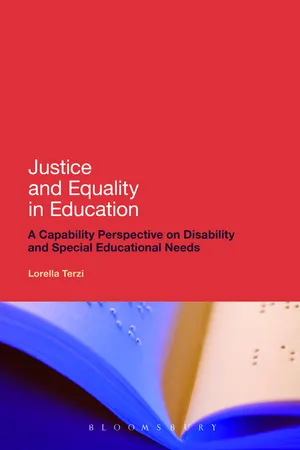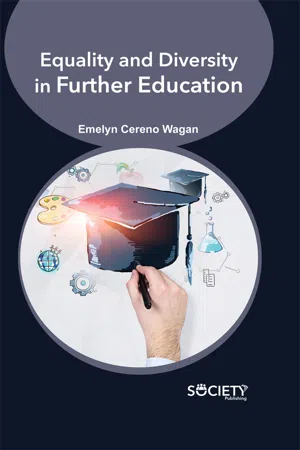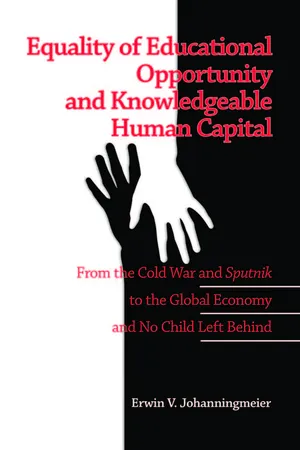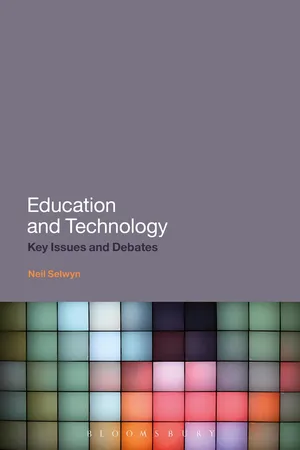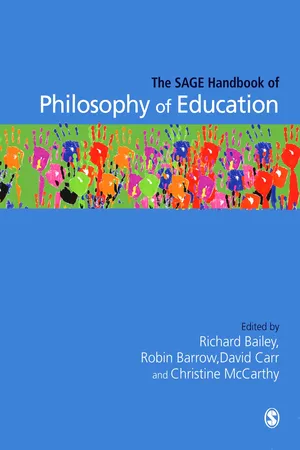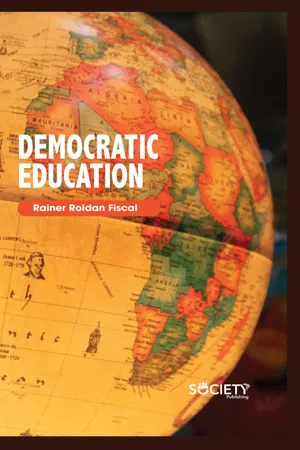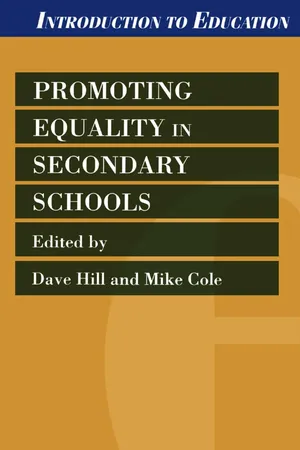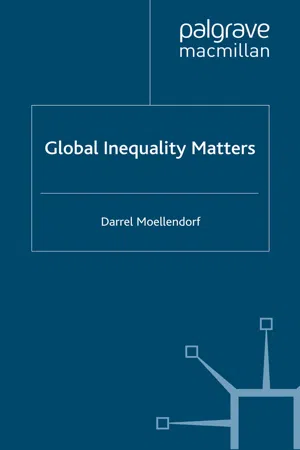Social Sciences
Educational Equality
Educational equality refers to the principle of providing all individuals with the same opportunities and resources in education, regardless of their background or circumstances. It aims to ensure that every person has access to quality education and is not disadvantaged due to factors such as race, gender, socioeconomic status, or disability. The goal is to create a level playing field for all students.
Written by Perlego with AI-assistance
Related key terms
1 of 5
11 Key excerpts on "Educational Equality"
- eBook - PDF
Justice and Equality in Education
A Capability Perspective on Disability and Special Educational Needs
- Lorella Terzi(Author)
- 2008(Publication Date)
- Continuum(Publisher)
Educational Equality is a fundamental principle of social justice. Yet despite the centrality of social justice and its extensive analysis in the theory and research of education, the concept of equality is conversely rather unspecified or vaguely theorized, and there is a lack of consensus on its implications for policy-making. However, the ideal of equality has a crucial normative role to play at two interconnected levels in education: the theoretical level, concerned with values and aims, and the level of pro-vision, relating to the enactment of these ideals into policy and practice. Consider the following two examples. A broad understanding of equality as equal entitlement to education informs many state systems of schooling. Yet while the idea that all children are equally entitled to education is generally accepted, the precise content of this goal is not only difficult to determine but also a source of controversy in itself. On the one hand, an equal entitlement to education can be seen as implying an equal provision of schooling, for example through a national curriculum. On the other hand, it can be understood as giving everybody an equal chance to develop and fulfil personal interests and talents, regardless of any common provision. Fur-thermore, an equal entitlement to education is a different concept from an entitlement to an equal education. While the former idea broadly relates to an equal right to learning, the latter often refers instead to the same quality education. Second, consider the relevance of equality in the provision of educa-tion, and hence, for instance, in terms of the design and implementation of school funding systems. Many funding formulae are the result of policies aimed at justice and claiming to apply equitable measures. However, both the understanding of justice in the distribution of resources, and the meaning of equity at policy level are often generic and imprecise. - eBook - PDF
- Emelyn Cereno Wagan(Author)
- 2020(Publication Date)
- Society Publishing(Publisher)
Principles of Equality and Diversity in Education 33 2.2. PRINCIPLES OF EQUALITY IN EDUCATION Every student has the right to develop oneself through a congenial learning atmosphere that caters to their requirements. It not only enhances their capabilities and perceives their individuality, but at the same time, drives them towards success. Time and again, students are restricted from availing the avenues of higher educational programs set up for them. In a system that usually underlines their growth, a lot of effort is needed from their end to prove their potentials. Educational Equality is like a channel designed for the empowerment of all students to help them achieve their goals (Figure 2.1). Figure: 2.1: Equality in education empowers students from all walks of life. Source: Image by Pexels. 2.2.1. Formal Equality of Educational Opportunity The formal rules which makes references to the traits such as race, gender, social class, religion, and sexuality and others should not act as a barrier in achieving certain goals. In other words, it stands for equality in front of the law and stands for anti-discrimination. The term formal is used because it advocates for removal of formal obstacles. For examples an educational institution cannot state in its admission policy that it is only open for male, white or students belonging to a certain social status. The educational institutes should not have entrance criteria which promotes inequality. Equality and Diversity in Further Education 34 Many societies are tolerant to schools being segregated by gender or religion. This may be fundamentally against the formal equality of education. However, many experts argue that this principle only holds for public education and private educational institutions are not bound by it. - Erwin V. Johanningmeier(Author)
- 2006(Publication Date)
- Information Age Publishing(Publisher)
Equality of Educational Opportunity: The Ideal and the Reality 61 (The Committee, 1956, p. 10). The Committee’s position was consistent with what the Supreme Court declared in Brown II. The Committee agreed: “that the great social, psychological, and organizational changes implicit in the recent decisions of the Supreme Court designed to abolish [racial] segregation in the public schools cannot be achieved with equal speed in every community.” It was a problem that had to “be worked out by each community in its own way within the framework of existing legal structures and the intent of the relevant Supreme Court decisions” (p. 10). In his remarks at the close of the conference McElroy indicated that “fair play for everyone” was a “driving force” and acknowledged that equal- ity of educational opportunity was an “emotional” as well as an important issue: We all recognize that the schools have become this nation’s most powerful instrument for preserving equality of opportunity—opportunity of all kinds. The schools are perhaps the chief expression of this country’s desire to treat everyone fairly. We Americans believe in competition, but in fair, unhandi- capped [sic] competition only. The material rewards our economy offers are closely geared to an individual’s ability and capacity for hard work. Let people do as well as they can, we say, but let them all begin as evenly as pos- sible. There is a patent unfairness about allowing some people to have their talents and attitudes cultivated during childhood, and allowing others to be neglected. That unfairness is abhorrent to all of us. We feel a fundamental lack of justice in poor schools, and that is why so many of us rally to improve education. That is one major reason why educational problems are so emo- tional.- eBook - PDF
Education and Technology
Key Issues and Debates
- Neil Selwyn(Author)
- 2011(Publication Date)
- Continuum(Publisher)
A range of socially created inequalities and differences can be found throughout any society – not least disparities in people’s income, health and housing. Alongside these issues, educational inequalities are perhaps one of the most important influences on an individual’s ‘life chances’. The ability to access and create knowledge, as well as the ability to gain the credentialization and qualifications that are linked with education, are all considered to be key assets in acquiring power, resources and prestige in contemporary society. Education is seen to be an especially important element of what is termed ‘social inclusion’ – that is, the extent to which individuals and groups are able to participate fully in society and control their own destinies. In short education is at the heart of how more or less ‘fair’ contemporary social life is for a person. As Lynsday Grant puts it, Learning is a process that can dramatically broaden the opportunities and choices available to an individual. At an instrumental level, learning skills and gaining qualifications opens up possibilities for employment, and access to fulfilling and rewarding employment is one key measure of social justice. This is the definition of learning often used in discussions around social justice and social mobility. But learning is also important to social justice in ways that go beyond this instrumental level. Learning is a process that can enable people to make their voices heard in the wider world and thereby exert agency over the future direction of their own lives and communities. Learning can build individuals’ self-confidence and a sense of their own efficacy. Learning therefore has an important role to play in . . . tackling the effects of deprivation, disadvantage and limited opportunities. (Grant and Villabos 2008, p. 4) If anything, education systems in most developed countries appear to have led to the continuation of inequalities and social stratification over the past 50 years or so. - eBook - ePub
Education, Justice and the Human Good
Fairness and equality in the education system
- Kirsten Meyer(Author)
- 2014(Publication Date)
- Routledge(Publisher)
Chapter 7 Fair equality of opportunity and educational justice Constantin StroopThe current debate on educational justice primarily focuses on the status and role of comparative considerations within a just distribution of educational benefits. The educational egalitarians Harry Brighouse and Adam Swift think that an unequal distribution of education is unjust because it leads to an unfair competition for social advantages. This is why their pluralistic account of educational justice contains an equal opportunity principle called the ‘meritocratic conception of Educational Equality’ (Brighouse and Swift 2008 and this volume).1 In contrast to this, advocates of an adequacy or sufficiency approach argue for providing a minimum level of education for all and do not consider educational inequalities above this level as problematic. Recently, however, Debra Satz (2007 and this volume) reshaped the idea of an adequate education with a comparative aspect by integrating Rawls’s principle of fair equality of opportunity into her conception of an educational threshold. Besides her concern for the absolute position of the worst off members of society, the move towards equality of opportunity is motivated by the issue of social inequality.Thereby, the idea of equality of opportunity marks an unexpected point of intersection between these two competing approaches to educational justice. Moreover, the overlapping formula appears to indicate some substantial agreement. In particular, by putting their money on the equal opportunity horse both approaches are aiming at a remedy of social inequality and, correspondingly, are considering equality of opportunity as a genuinely egalitarian idea.2 Additionally, both explicitly refer to Rawls’s principle of fair equality of opportunity. Thus, this latest chapter of the recent debate about educational justice provides the perfect occasion to face a complex of interrelated questions on opportunities and education: What does educational justice have to do with equality of opportunity? What follows from accepting fair equality of opportunity for the question of how educational goods and benefits should be distributed? In which currency is the good of education to be distributed: as educational resources, educational opportunities, or educational attainments? And in particular, can Rawls’s principle of fair equality of opportunity properly motivate to focus on educational opportunities and thereby support the corresponding ideal of equal educational opportunity which is often regarded as the ‘classical idea’ (Giesinger 2011: 43) of educational justice?3 - eBook - PDF
- Richard Bailey, Robin Barrow, David Carr, Christine McCarthy, Richard Bailey, Robin Barrow, David Carr, Christine McCarthy(Authors)
- 2010(Publication Date)
- SAGE Publications Ltd(Publisher)
This idea is more egalitarian; that is, it has as an explicit purpose – the reduction of social inequality. Authors who focus on equity seek not to overcome or reduce all inequalities, but to redress specifically those inequalities they consider unjust because they are outside the sphere of control of the subject bearing them. 406 THE SAGE HANDBOOK OF PHILOSOPHY OF EDUCATION For example, if two students in the same school and class take the same test, but one student has studied diligently for the test while the other has not, the expected differential outcome in their grades appears to be a justifiable inequality. Treating the students unequally, for example, by allowing one but not the other to redo the test in an attempt to improve the grade, would, then, be unfair. However, if it turns out that the student who has studied diligently has her own room in which she can study quietly, and does not have an after-school job, while the student who has not studied shares his room with two younger siblings for whom he is expected to care after school, the inequality appears less justifiable. The two students in this example may be said not to have the same opportunity to succeed, and under the conception of justice as equity it is justifiable to treat the students unequally to improve the equality of their opportunity. Likely, the best-known proponent of the idea of justice as equity is American political philosopher John Rawls. In his influential A Theory of Justice (1971) he proposes the following two principles of justice: 1 Each person is to have an equal right to the most extensive total system of basic liberties compatible with a similar system of liberty for all. 2 Social and economic inequalities are to be arranged so that they are both: (a) to the greatest benefit of the least advantaged ... and (b) attached to office and positions open to all under conditions of fair equality of opportunity. - eBook - PDF
- Rainer Roldan Fiscal(Author)
- 2019(Publication Date)
- Society Publishing(Publisher)
The issue is escaped if positional inequality is not attended to through equalization of educational opportunity. To help promote democracy in the world this chapter explores democratic education and how it can help bring about equality in education. 6.2. THE IDEA OF FAIRNESS If we were requesting questions of the kids in a class, we wouldn’t ask just one single person, again and again, right? We’d want to pass on the questioning around. Or if we owned a class question, we wouldn’t let just one single learner speak for the complete session, right? We’d want to ensure some different voices were read. We wouldn’t design our testing so that only one person could complete. We wouldn’t coordinate our collection so that literature was only open to one student. Within a public endeavor like learning, there’s a principle of collateral at the job. Though we may well not always abide by it correctly or completely, we tend to make an effort to make our classrooms reasonable: fairness in learning, fairness in evaluation, fairness in compensation. There keeps growing recognition that there could be something to the concept. One significant observation from the just lately released international examination of learner learning, PISA, is the fact that countries that address public inequalities show better learning effects , while countries that dismiss them remain fixed or commence to drop in the positions. AMERICA arrived only in the center of the PISA search positions. Why? As Kevin Carey published, “Among the reasons, Canada is our biggest trading spouse is that it includes a well-balanced democratic authority and Democratic Education and Equality 105 a highly-developed current economic climate… If you run-down the set of our closest advanced schooling opponents—Finland, New Zealand, Norway, and Japan—you can make similar observations. - eBook - PDF
- David Hill, Mike Cole(Authors)
- 1999(Publication Date)
- Continuum(Publisher)
CHAPTER 1 Equality and secondary education: what are the conceptual issues? Mike Cole and Dave Hill EQUALITY AND EQUAL OPPORTUNITIES This book is premised on the conviction that all those connected with the education of young people should have a sound awareness of equality and equal opportunity issues. In this chapter, we provide a conceptual overview of the issues of social class, 'race', sexuality, gender, and disability and special needs as a means of informing the chapters in the rest of the book which deal with these issues with respect to the various subjects of the Secondary Curriculum. The book is aimed at teachers, headteachers, school governors, parents, student teachers, school mentors, non-teaching staff, teacher educators and trainers, and others involved in secondary schooling. Its purpose is to encourage and assist them in promot-ing equality in secondary schools. As far as the equality issues discussed in this book are concerned, a number of important points need to be made at the outset. First, a distinction needs to be made between equal opportuni-ties on the one hand, and equality on the other. Equal opportunities policies, in schools and elsewhere, seek to enhance social mobility within structures which are essentially unequal. In other words, they seek a meritocracy, where people rise (or fall) on merit, but to grossly unequal levels or strata in society: unequal in terms of income, wealth, lifestyle, life-chances and power. 1 Promoting Equality in Secondary Schools Egalitarian policies (policies to promote equality) on the other hand, seek to go further. - eBook - PDF
- D. Moellendorf(Author)
- 2009(Publication Date)
- Palgrave Macmillan(Publisher)
Moreover, different forms of equality of opportunity assume differ- ent equal endowments, for which social arrangements are to equal- ize opportunities. For example, equality of opportunity for income assumes persons of approximately equal talents, abilities and moti- vations. Or at least, such an assumption seems reasonable within the context of economies containing labor markets. Whereas equality of opportunity for a statistically normal life span assumes persons of equal states of health. The point is to equalize opportunities with respect to what seem to be morally relevant endowments so as to pre- vent opportunities from being a function of factors that are morally arbitrary. Although we do not want a principle of equality of oppor- tunity to live a statistically normal life span to allow that a person’s talents, abilities and motivation are relevant, we may want a prin- ciple of equality of opportunity for income to allow that these are relevant. Global Equality of Opportunity Defended 75 I argued in Chapter 3 that duties of social and political justice are associative, and that although egalitarian in form in virtue of respect for the dignity of persons, their content was dependent upon the kind of association. Assuming that conclusion, we may specify the content of the ideal of equality of opportunity with refer- ence to the kind of association that generates the duties of justice and the goods of that association that are a concern of justice. For exam- ple, the fundamental category of participation and status in a state, or political community, is citizenship. Equality of opportunity for cit- izenship is a complex ideal involving several different components, including for example education, liberty and basic well-being. Alter- natively, there are several important goods produced and affected by an economic association. - eBook - PDF
- OECD(Author)
- 2012(Publication Date)
- OECD(Publisher)
The persistent patterns of inequality have been highlighted, with the increasing quality of international data permitting analyses relating to many pertinent groups of learners and their educational experiences. OECD analysis has shown that there need be no contradiction between equity and efficiency, and indeed has underlined how damaging to economic as well as social goals is the phenomenon of exclusion and widespread under-achievement. A major international review of equity in education resulted in No More Failures, published in 2007, which outlines ten broad policy directions around the design of provision, practices and resourcing. The second report of the review – Equity and Quality in Education , published in 2012 – provides five core recommendations for preventing school failure and promoting the completion of upper secondary and a further five for supporting the improvement of low-performing disadvantaged schools. The charting of the outcomes of, and opportunities and policies for, different population groups has been undertaken across the many sectors of education and training, including longstanding work on special educational needs. Ethnic and cultural diversity makes society richer, but reaping the full benefits requires special efforts from the education system. The OECD Thematic Reviews on Migrant Education have examined the education outcomes of the children of immigrants in five OECD countries. PISA 2009 Results: Overcoming Social Background complements this work as it provides rich insight into the equity in learning opportunities and outcomes of students with different socio-economic backgrounds. - eBook - PDF
- Thomas Piketty, Steven Rendall(Authors)
- 2022(Publication Date)
- Belknap Press(Publisher)
8 • REAL EQUALITY AGAINST DISCRIMINATION Let us now return to the question of social and racial discrimination, and especially to equality of access to training and employment. One of the major limits of the movement toward equality that occurred in the course of the past century is that it was too often limited to a formal equality. In short: we have proclaimed the theoretical principle of the equality of rights and opportunities, independent of origins, but without giving ourselves the means to determine whether this principle corresponds to reality or not. If we want to attain real equality, we must develop indicators and procedures that will allow us to fight gendered, social, and ethno-racial discrimination, which is in practice endemic nearly everywhere, in the global North as well as in the South. In practice, one of the biggest difficulties is to suc- ceed in combating tenacious prejudices without rigidifying identities. There is no single answer to this dilemma, and the solution may de- pend on the national and postcolonial context in question. Only a calm examination and comparison of experiences in Europe, the United States, India, and other parts of the world can allow us to sketch out avenues for understanding, while at the same time resitu- ating the struggle against discrimination in the more general frame- work of a social policy with universalist objectives. 176 A B R I E F H I S T O R Y O F E Q U A L I T Y Educational Equality: Always Proclaimed, Never Realized We will begin with the question of educational justice: the diffusion of knowledge has always been the central tool enabling real equality, beyond origins. But the problem is that almost everywhere there is a monumental gap between official statements regarding equality of op- portunities and the reality of the educational inequalities that the disadvantaged classes face.
Index pages curate the most relevant extracts from our library of academic textbooks. They’ve been created using an in-house natural language model (NLM), each adding context and meaning to key research topics.
